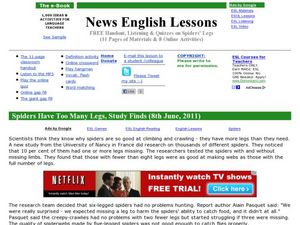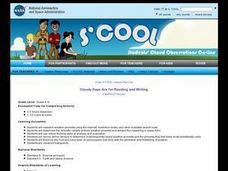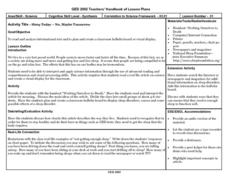Curated OER
No Impact Project: Water
Students use the "No Impact Project" to analyze the consumption of water. In this water consumption lesson, students discuss the pros and cons of tap water or bottled water. Students read about chemicals in water and watch a video clip...
Curated OER
Spiders Have Too Many Legs, Study Finds
Students explore current events by answering study questions about an article. In this arachnids instructional activity, students read a recently published article which discusses the importance of spiders and their 8 legs. Students...
Curated OER
Summarize What You Read
Third graders summarize a selected piece of nonfiction text. After reviewing the correct way to use a Venn diagram, 3rd graders read a nonfiction article. They write a summary paragraph using their Venn Diagram and the five-step process...
Curated OER
Reading Predictions
Second graders read and predict content and purpose for table of contents, index, headings, captions, illustrations, and major words from their science or social studies textbooks. They use books' elements to summarize what they can find...
Curated OER
The Social Effects of the Great Depression
Students explore U.S. history by listening to an economics lecture. In this Great Depression lesson plan, students read a letter written to the President during the worst economical disaster in U.S. history. Students answer study...
Curated OER
What are the Challenges?
Students discuss energy. In this energy challenges lesson, students read about greenhouse gas emissions and global climate change. Comprehension questions from the reading are provided.
Curated OER
Plant Diversity
In this nonfiction comprehension worksheet, learners read the selection on plant diversity and answer 10 questions that include true/false, short answer, multiple choice, and fill in the blank.
Curated OER
Calorimetry Lab
In this calorimetry lab, students apply the information read about a calorimeter to conduct a scientific investigation. Students record their data in a chart. Students use the information from the chart to calculate specific heat of...
Curated OER
Winter
Students explore the concept of hibernation. For this winter lesson, students read Time to Sleep by Denise Fleming and discuss the content of the story. Students participate in classroom activities that require them to develop their...
Curated OER
The Amoeba
In this amoeba instructional activity, students read a selection about the amoeba, then answer a set of 7 comprehension questions and color and label a diagram of an amoeba.
Curated OER
Fish Communities in the Hudson
In this Hudson River worksheet, students read about fish communities in the river and complete related graph and comprehension activities.
Curated OER
Breeding Bird Atlas Activity
In this breeding birds worksheet, students read a passage about birds and the Breeding Birds Atlas, then answer a set of comprehension questions based on graphs, maps and pictures given. Questions have multiple components.
Curated OER
Growing Seeds
In this science worksheet, students read 5 different scenarios with varied growing conditions for plants. Students make a prediction for each: Will it grow a little, grow a lot, or not grow at all?
Curated OER
Cloudy Days Are for Reading and Writing
Students consider a variety of well-known proverbs that refer to the weather. They research the scientific validity of these proverbs, conduct interviews about public perception of the proverbs and summarize their findings in writing.
Curated OER
Eye Spy Science
Fourth graders identify the four kinds of violent storms. Using photographs, they create "eye spy" questions for each and mount them on construction paper. They write a brief summary for each photo and share the questions with the class...
Curated OER
Reading A Weather Map
Ninth graders construct a weather map. In this meteorology lesson, 9th graders construct a weather map using contour lines and temperature.
Curated OER
Sleep Today - No, Maybe Tomorrow
Learners read and interpret handout about sleeping habits and disorders, and plan and create classroom bulletin board that displays causes, disorders and effects of sleep deprivation.
Curated OER
The Water Cycle
In this water cycle worksheet, students read an informational passage, observe a labeled diagram of the transpiration water cycle, and answer comprehension questions. Students answer seven multiple choice questions and write a story from...
Curated OER
Computer Basics For Kids Worksheet
The computer can be a wonderful tool with so many applications. Third graders read a four paragraph procedural text to learn about: central processing unit, memory, input, output. They answer four fill in the blank and multiple choice...
Learning Station
Point of View—Picking Favorites
For this writing worksheet, learners discover how a story can change depending on the point of view the writer has chosen. Students read several excerpts from stories and respond in writing to how they are different.
Sundance
Teaching Strategies: The Giver
Can utopia be achieved? Included here are three literature worksheets to pair with Lois Lowry's The Giver. Pupils work in groups to come up with solutions to society's issues, individuals back up a statement related to a topic in the...
Lerner Publishing
Teaching Habitats
What makes up a habitat? Use this resource to engage first graders in the exploration of desert, wetland, forest, and ocean habitats. Youngsters classify plants and animals into the four distinct habitats through drawings and cutting and...
Curated OER
Do Touch!
Students explore the sense of touch. They investigate unknown solids using the sense of touch. Pupils use their senses of touch to match feely gloves. Students explore body parts, by tracing their hands and feet on paper. They create a...
Curated OER
Scientific Method: How Many Drops of Water Fit on a Coin?
Young investigators conduct an experiment using the scientific method. They see how many drops of water fit on a coin; have them conduct several different trials. This involves making a hypothesis, looking at controls, and introducing...

























